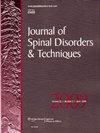Do You Need to Use a Collar After a 2-level Instrumented ACDF?
Q Medicine
引用次数: 7
Abstract
A lthough radiographic outcomes do not necessarily correlate with clinical outcomes, achieving a successful arthrodesis remains an intended and desirable goal of anterior cervical discectomy and fusion (ACDF) surgery. One of the main determinants of successful arthrodesis is stable fixation, which immobilizes the segments to be fused. Currently, plating is the most widespread and effective means of accomplishing this goal. External bracing with a collar is another method that was historically more popular as a “stand alone” means of immobilization, but now is typically used adjunctively with plating. The use of cervical collars after ACDF remains a matter lacking consensus among surgeons, as demonstrated by a survey study1 showing that 55% of spine surgeons surveyed reported use of some form of postoperative immobilization after 1-level ACDF, albeit usually a soft collar. This is in contrast to 2level surgery, after which 70% of surgeons reported use of a collar, with the majority selecting a rigid orthosis. Admittedly, in 1-level ACDF surgery, the literature has yet to demonstrate that bracing improves results—although the data are by no means conclusive. A limitation of the Campbell study, for example, is that it centered on the fusion cohort of a cervical disk replacement safety and efficacy trial, and hence was not optimized to detect differences among braced and nonbraced ACDF patients. These patients were not randomized to a braced or nonbraced group, but were retrospectively examined to determine clinical and radiologic outcomes. Furthermore, because the fusion rates of single-level plated ACDF are already relatively high,3 with many studies near or at 100%, currently available studies regarding bracing are likely underpowered to demonstrate an incremental improvement with the addition of a brace. Two-level ACDF, however, represents a more challenging scenario associated with greater biomechanical demands than 1-level surgery. As such, bracing 2-level or more ACDFs may have a greater incremental benefit when used in conjunction with plating. One of the primary dictums in medicine is “primum non nocere”—first do no harm. If a treatment modality not only has minimal risk of causing harm but could also provide tangible benefit, then it should be strongly considered in patient care. We argue that adjunctive bracing of 2-level ACDF is such a modality for the following reasons. First, bracing has been shown to increase immobilization of the spine. In a study by Askins and Eismont,4 the NecLoc cervical orthosis was shown to allow only 17% and 23% of normal range of motion in flexion and extension planes, respectively, whereas also allowing only 27% of normal rotation. Admittedly, bracing does not totally immobilize the spine. However, it clearly decreases motion versus no brace, and it also serves as a reminder to the patient to avoid excessive cervical motion during the initial healing phase of surgery. Prasarn et al5 demonstrated that 2-level ACDF, when compared to 1-level surgery, leads to increased motion (31.3% at the cranial segment and 33.8% at the caudal segment) and thus stress at adjacent levels, and is also associated with an overall 37% increase in stiffness of the cervical spine. Increasing stiffness suggests that, to achieve a given amount of cervical motion, more force would need to be applied. Similarly, increased motion at adjacent levels may signify an increase in shear forces acting on either end of the instrumentation construct. This increased stiffness and increased motion at adjacent levels may contribute to the higher nonunion rate seen in 2-level surgery6; any additional immobilization would likely confer improved arthrodesis success. Second, bracing is associated with minimal complications. Powers et al7 demonstrated that, even in a trauma population (thought to be at much higher risk Received for publication May 20, 2015; accepted May 20, 2015. From the *Department of Orthopaedic Surgery, Emory Spine Center, Emory University, Atlanta, GA; and wDepartment of Orthopaedic Surgery, Northwestern University Feinberg School of Medicine, Chicago, IL. E.O.B. previously received research funding from CSRS and J.M.R. has served on the board of CSRS and declares financial relationships with Biomet, Zimmer, and Phygen/Alphatec. The remaining authors declare no conflict of interest. Reprints: John M. Rhee, MD, Department of Orthopaedic Surgery, Emory Spine Center, Emory University, 59 Executive Park South, Atlanta, GA 30329 (e-mail: jmrhee@emory.edu). Copyright r 2015 Wolters Kluwer Health, Inc. All rights reserved. CONTROVERSIES IN SPINE SURGERY2级ACDF仪表化后是否需要使用项圈?
本文章由计算机程序翻译,如有差异,请以英文原文为准。
求助全文
约1分钟内获得全文
求助全文
来源期刊
CiteScore
2.16
自引率
0.00%
发文量
0
审稿时长
3 months
期刊介绍:
Journal of Spinal Disorders & Techniques features peer-reviewed original articles on diagnosis, management, and surgery for spinal problems. Topics include degenerative disorders, spinal trauma, diagnostic anesthetic blocks, metastatic tumor spinal replacements, management of pain syndromes, and the use of imaging techniques in evaluating lumbar spine disorder. The journal also presents thoroughly documented case reports.

 求助内容:
求助内容: 应助结果提醒方式:
应助结果提醒方式:


